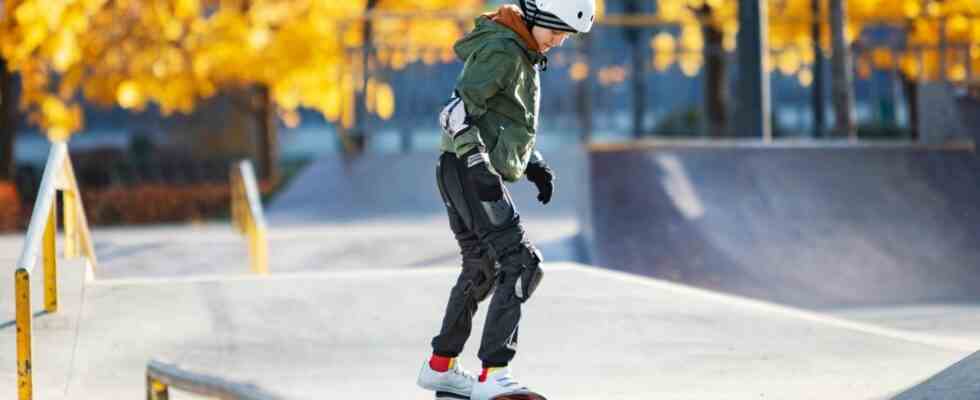trend sport
Skateboards for kids: how to find the right model
Skateboards train balance and body awareness. And most importantly, skateboarding is fun. How to find the right model and equipment for your child.
© JulPo / Getty Images
Scooters were yesterday. Skateboards are becoming the new trend sports equipment for children and young people. Which boards are suitable for which age and what equipment is essential – a small checklist.
The times when skateboarders were laughed at as freaks are long gone. As early as the 1970s, young people rattled up and down the legendary Venice Beach in Los Angeles with a wooden board screwed onto four wheels. The daring tricks and jumps often ended in injuries. Today, more than 50 years later, many things are different. Skateboarding is almost socially acceptable. Yes, the freaks in worn-out jeans and oversized sweaters are still rolling down the ramps of graffiti-sprayed skater parks. But similar to the snowboard scene, skateboarders found their way into international sport a few years ago. Medals were awarded for the first time at the 2021 Summer Olympics in Tokyo – in the Park and Street disciplines. The celebrated heroes of the scene and at the same time the best skaters in the world are schoolchildren and young people. The British Sky Brown is 14 years young and already a superstar. It’s no wonder that more and more children are switching from scooters to skateboards.
In the following article you will find out which skateboards are suitable for children and what beginners should pay attention to during the first training rounds.
Skateboards for kids: mini cruiser vs. kids board
They are colourful, lightweight and fully assembled. For a few years, the so-called mini cruiser or pennyboards on the rise in the skater scene. And it is precisely these boards that can make it easier to get started with skateboarding. This is for children from the age of three who have some talent for movement mini board perfect to try out. Important: This plastic boards are only designed for rolling and are not suitable for tricks. Similar to shoes and scooters, there are boards for little skaters with colorful LED lights in the wheels.
After this warm-up, the ground is prepared for the first “real” skateboard. Here the kids are already standing on a wooden board, which essentially only differs from the skateboards for adults in terms of its length. These classic boards are suitable for beginners as well as for brave skaters with some experience. They are typically 31 inches long. That corresponds to about 80 centimeters. With the width of the board, care should be taken to ensure that the tips of your toes protrude slightly over the edge of the board. The skateboard can be controlled better.
Skateboards for kids: checklist
- First attempts possible from the age of three years
- Skateboard should be slightly narrower than the child’s shoe length at the beginning
- It is best to start with a mini or penny board (made of plastic)
- next level: kids board (also suitable for beginners)
- a stylish skater helmet (bicycle helmet is also sufficient for the beginning) as well as knee, elbow and wrist protectors are mandatory (a complete equipment set is available here)
Skateboards for kids: What else is important
Unlike riding a bike or scooter, skateboarding involves standing at right angles to the direction of travel. This is initially unusual for beginners. That’s why parents should always be there when their mini skaters are first tested. With a little trick you can find out which leg is best in front of the board. Without warning, give your child a gentle nudge. The leg that puts it forward to catch itself is also on the skateboard forward in the direction of travel. The same trick also works for snowboard beginners. Otherwise, it is first important that the children stand safely and stably on the board with slightly bent knees. Abandoned parking spaces are ideal for the first practice sessions. Skateboarding gives you the momentum you need by pushing off the ground with one leg. The rule here is: the more often, the faster. Two to three short ground contacts are enough to start with.
Skateboards in traffic: These are the rules
- Skateboards are not vehicles according to Section 24 Paragraph 1 of the Road Traffic Act. They are legally treated like wheelchairs or toboggans.
- The same rules apply to skateboarders as to pedestrians
- Skateboards may not be used on public roads.
- Cycle paths are also taboo for skateboarders.
- It is compulsory to drive on the sidewalk.
Last tip: Almost every major city in Germany now has at least a small practice facility for skaters. For starters, the halfpipe and kicker are still taboo. But it certainly doesn’t hurt to see what it can look like.
You might also be interested in:
This article contains so-called affiliate links. Further information are available here.

